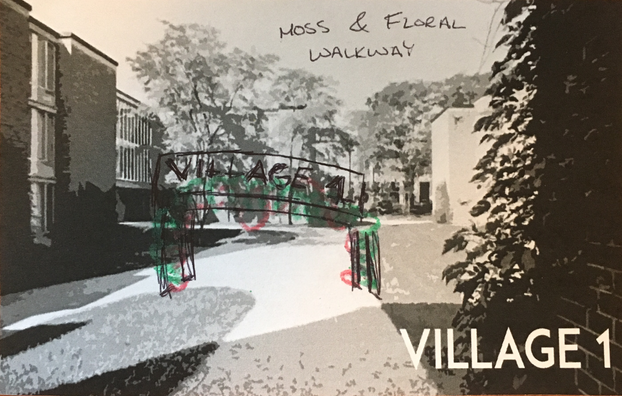
Endless
Possibilities

WELCOME TO THE LIVING CAMPUS EXHIBIT
Inspired by the tensions and possibilities between informal green spaces and formal managed designs, we asked members of the UW community what an ideal campus environment might look like.
Click each photo for a detailed concept explanation and how the design benefits students. Interspersed between renders are thoughts from campus students, staff, and specialists, reflecting on questions such as: “What can be done to incorporate more nature into our urban surroundings?” and “What works best, for in what contexts, and serving what definition of sustainability?”
We hope you enjoy this collection of thoughts andvisions about the future of campus sustainability.
What questions, ideas, or realizations about the relationship between yourself, nature, and campus come to mind as you browse?
What green spaces do you want to see on campus?

“Green spaces build community, whether it be a sporting event, BBQ, or gardening.” - Nicole Balliston
Co-CEO of Polygone Technologies and University of Waterloo PhD Candidate

“Our campus was built in the 1970s during the Brutalist phase. At that time, architects liked making mazes out of concrete. They were built with ideas that were designer-centric, not user-centric. Times have changed, and there is a lack of campus adapting to student issues and concerns."
- Sheida Shahi
Architect, PhD candidate in Civil and Environmental Engineering, Research Fellow at WISE (Waterloo Institute for Sustainable Energy)



… And there’s the distinction between “sustainability” and “environmental sustainability”. You’re talking about environmental sustainability here. It’s not bad, but it’s not the whole story! Sustainability is about all things needed so that when you’re my age, things are okay.It works interactively between one’s household and planet. Many interconnections. Are there any ecological resources left? A lot is about the billions who don’t have enough. When the basic concept of sustainable development was popularized in the 80s, the essence was dealing with poverty and environmental issues at the same time. They are interconnected and dependent. The essence is not the environmental part, it is the interconnected part. The social justice and economic stuff.”
Professor at School of Environment, Resources, and Sustainability, editorial board chair of Alternatives Journal since 1984
IDEA SPOTLIGHT:
Living
Bus Stop


The breathing bus shelter is a concept that integrates a micro-algal ecosystem into the materials that make up the structure itself. The bus shelter allows people to discover and reconnect with the wondrous mechanisms of nature in an otherwise boring part of their daily commute. The wall and roof panels would make up an automated environment with controls programmed to optimize the growth of algae within it.
The resources and power for the bus shelter will be contained and interfaced with from the control box underneath the bench in the shelter. The sun naturally creates algal blooms, which result in the shelter becoming a sunshade on hot days. On cloudier or cold days, the algae will be filtered out and collected either as food or fertilizer, allowing more natural light into the shelter for the commuters within. The algae-panels could also be replaced with moss panels.
John Webster developed this idea further in a business course investor presentation: https://youtu.be/nHmHvJptx6w


IDEA SPOTLIGHT:
Residence Gazebo



The idea was proposed by a classmate to have a sheltered space covered in plants situated in a densely habituated area on campus. Recognizing the importance of having functional greenspaces for the community to promote people to spend time in nature, we have added picnic tables underneath this shelter to allow people to hang out comfortably in the rain, or work peacefully amid fresh air. The planters on the sides of the gazebo would help block wind and the roof can provide suncover, creating a book and laptop-friendly space to work.

Dweep's Sketch of the Psychology, Sociology and Anthropology (PAS) Building
"In India, buildings tend to have a lot of plants, living, and large, indoors. Why don’t we do that here? Even sitting here in the DC Cafeteria, putting a big potted plant in either corner would make this space so much more inviting.
I’ve read in a research study that if you have good green spaces on campus, the concentration and productivity of people goes up. They’re more satisfied with their campus overall."
Coordinator of Sustainable Campus Initiative at Waterloo Undergraduate Student Association (WUSA)



“We want to do it [sustainability]. We want to do it right.
And we want to be leaders. We don't want to do something part-way—there’s a lot of due diligence. It’s not a fear to fail. But let’s get the best information we can to start moving things forward.”
Associate Director of Undergraduate Studies at the School of Environment, Enterprise, and Development (SEED)









